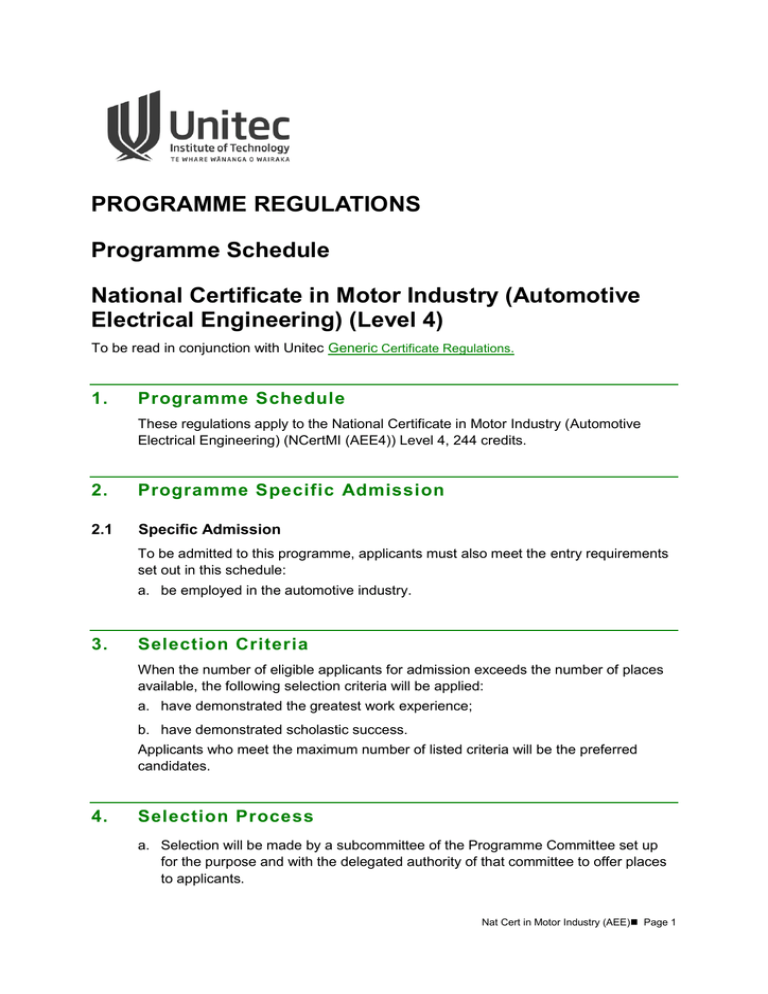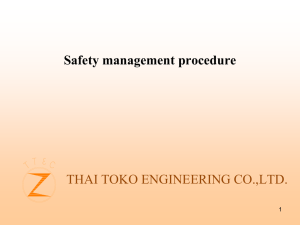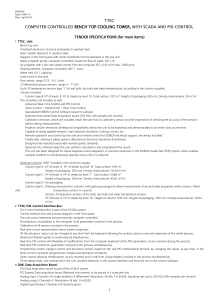Automotive Electrical Engineering
advertisement

PROGRAMME REGULATIONS Programme Schedule National Certificate in Motor Industry (Automotive Electrical Engineering) (Level 4) To be read in conjunction with Unitec Generic Certificate Regulations. 1. Programme Schedule These regulations apply to the National Certificate in Motor Industry (Automotive Electrical Engineering) (NCertMI (AEE4)) Level 4, 244 credits. 2. Programme Specific Admission 2.1 Specific Admission To be admitted to this programme, applicants must also meet the entry requirements set out in this schedule: a. be employed in the automotive industry. 3. Selection Criteria When the number of eligible applicants for admission exceeds the number of places available, the following selection criteria will be applied: a. have demonstrated the greatest work experience; b. have demonstrated scholastic success. Applicants who meet the maximum number of listed criteria will be the preferred candidates. 4. Selection Process a. Selection will be made by a subcommittee of the Programme Committee set up for the purpose and with the delegated authority of that committee to offer places to applicants. Nat Cert in Motor Industry (AEE) Page 1 b. Applicants may be required to attend an interview. 5. Requirements for the Award of the Qualification 5.1 National Certificate in Motor Industry (Automotive Electrical Engineering) To be awarded the National Certificate in Motor Industry (Automotive Electrical Engineering) (Level 4, 244 credits), students must have satisfied the following requirements: a. the successful completion of all compulsory practical and theory units and a minimum of 30 credits from elective courses listed in 5.2; and b. although students may be awarded credit through credit recognition and/or APL (as specified in clauses 6 and 7 below), a minimum of fifty per cent of the credits required for the award of the certificate must be achieved in courses offered by Unitec; and c. credit gained for a standard may be used only once to meet the requirements of this qualification; and d. unit standards and achievement standards that are equivalent in outcome are mutually exclusive for the purpose of award. The table of mutually exclusive standards is provided on the New Zealand Qualifications Authority (NZQA) website: http://www.nzqa.govt.nz/qualifications-standards/standards/standardsexclusion-list; and e. reviewed standards that continue to recognise the same overall outcome are registered as new versions and retain their identification number (ID). Any version of a standard with the same ID may be used to meet qualification requirements that list the ID and/or that specify the past or current classification of the standard. Table 1: Credits for National Certificate in Motor Industry (AEE) level 4 Automotive Electrical Engineering Strand Compulsory Level 1 credits 3 Level 2 credits 65 Level 3 credits Level 4 credits Minimum totals Qualification totals 68 78 214 Elective 30 244 Nat Cert in Motor Industry (AEE) Page 2 5.2 Course details Table 2: Compulsory courses for National Certificate in Motor Industry (AEE) level 4 Course number Course Title Level Credit TTEC US56 Attend to customer enquiries face-to-face and on the telephone Pick up and deliver a customer's vehicle, machine, or equipment Provide customer service in given situations 1 2 1 1 2 2 2 4 2 5 2 5 2 4 TTEC US232 Carry out general engineering tasks to repair and make automotive components Select and use hand tools and workshop equipment for an automotive application Identify the functions and general locations of motor vehicle systems and components Explain the operation of two and four stroke petrol and diesel engines Test an automotive electrical circuit 2 8 TTEC US233 Service an automotive battery 2 2 TTEC US234 2 4 TTEC US235 Describe automotive starting and charging systems and their operation Describe automotive ignition systems and their operation 2 3 TTEC US236 Service automotive cooling systems 2 4 TTEC US237 Describe automotive brake, steering, and suspension systems, and their operation Demonstrate knowledge of automotive manual transmissions Demonstrate knowledge of petrol fuel systems 2 3 2 2 2 3 Describe the operation of a diesel fuel system and perform minor servicing tasks Carry out basic tuning on a four stroke petrol engine 2 3 2 4 Select and apply lubricants and sealants for automotive and related industry applications Prepare a vehicle and/or machine for use and shut-down after use Maintain automotive stock and plant security 2 2 2 2 2 2 Clean automotive components and maintain cleaning equipment Demonstrate knowledge of safe working practices in an automotive workshop Overhaul a starter motor from a car and/or light commercial vehicle Test, diagnose, and rectify faults in a contact breaker (CB) ignition system on an engine Test, diagnose, and rectify faults in a conventional type electronic ignition system on an engine Diagnose and repair faults in starting and charging systems on cars or light commercial vehicles Identify an automotive wiring diagram and translate information to a motor vehicle circuit 2 1 2 2 3 3 3 2 3 4 3 5 3 3 TTEC U15368 TTEC US57 TTEC US227 TTEC US228 TTEC US229 TTEC US231 TTEC US239 TTEC US240 TTEC US241 TTEC US243 TTEC US245 TTEC US247 TTEC US392 TTEC US924 TTEC U16113 TTEC US888 TTEC US891 TTEC US895 TTEC US897 TTEC US898 Nat Cert in Motor Industry (AEE) Page 3 Course number Course Title Level Credit TTEC US899 Carry out automotive wiring repairs and test circuits for serviceability Test a vehicle heating and ventilation system 3 3 3 3 Install, repair, and replace electrical accessories in vehicles Service multiple battery installations on heavy commercial vehicles, machines, or units Demonstrate knowledge of automotive air conditioning 3 2 3 2 3 4 Demonstrate knowledge of vehicle security systems and their installation Inspect and test an ignition distributor, and rectify faults 3 4 3 2 Demonstrate knowledge of, and work in proximity to, motor vehicle air bag mechanisms Respond to vehicle breakdown 3 2 3 1 3 4 3 4 3 4 3 4 TTEC US5464 Check a four stroke petrol engine for condition using hand held test equipment Explain the operation of automotive alternators and alternator controls Explain the operation of automotive electronic fuel injection systems Explain the operation and testing of automotive emission controls Explain automotive electrical and electronic applications 3 12 TTEC US887 Diagnose and repair automotive wiper system faults 4 2 TTEC US906 4 4 4 5 TTEC US934 Diagnose and rectify automotive climate control system faults Diagnose and rectify faults in automotive instruments and gauges Cost a job for an automotive repair or service 4 3 TTEC US946 Book in work for an automotive business 4 4 TTEC US968 Estimate the cost of an automotive repair 4 4 TTEC U15384 Demonstrate knowledge of electronic diesel management 4 4 TTEC US2348 4 8 4 5 4 8 TTEC US5457 Diagnose and rectify faults in vehicle and machine body electronics Demonstrate knowledge of vehicle lighting and rectify lighting circuit faults Describe the application of electricity and electronics for marine use Test and repair automotive alternator circuits 4 4 TTEC US5458 Explain the operation of heavy duty starter motors 4 4 TTEC US5460 Test and repair automotive electronic fuel injection systems Explain the operation of automotive electronic ignition systems Explain the operation and repair requirements of automotive electronic control systems Diagnose and rectify faults in automotive electronically controlled systems 4 4 4 5 4 8 4 6 TTEC US902 TTEC US909 TTEC US915 TTEC U15373 TTEC U16114 TTEC US2326 TTEC US2629 TTEC US3387 TTEC US3400 TTEC US5456 TTEC US5459 TTEC US5461 TTEC US910 TTEC US3399 TTEC US5433 TTEC US5462 TTEC US5463 TTEC US8182 Nat Cert in Motor Industry (AEE) Page 4 Table 3: Elective courses for National Certificate in Motor Industry (AEE) level 4 A minimum of 30 credits are required. 6. Course number Course Title Level Credit TTEC US230 Repair and make with oxy-acetylene 2 3 TTEC US242 Change and bleed hydraulics 2 2 TTEC US385 Sell automotive products 3 4 TTEC US904 Diagnose and overhaul generator systems 3 5 TTEC US890 Diagnose / repair motorcycle start / charge 4 4 TTEC US905 Overhaul starter from heavy commercial 4 5 TTEC US5436 Diagnose and repair faults in marine starting system 4 4 TTEC U15370 Knowledge of business responsibilities 4 4 Credit Recognition and Exemptions a. The Programme Committee may award a student credit recognition subject to the provisions in the Generic Certificate Regulations and subject to clause 5.1.b above. b 7. The credit recognition must be specified, where there is direct equivalence of the learning outcomes of a completed unit and a unit in the certificate. Assessment of Prior Learning Applications for recognition of prior learning should be made to the NZ Motor Industry Training Organisation (http://www.mito.org.nz/files/RCC_Factsheet_(V4)_web.pdf) 8. Assessment 8.1 General a. Assessment is competency based. b. All assessment events must be passed in order to gain a pass for a course. 8.2 Calculation of course grades a. Course grades will be reported according to the following criteria: Table 4: Course Grades Grade Status P Pass NC Not Yet Competent Nat Cert in Motor Industry (AEE) Page 5 b. Students may also be awarded one of the following grades where appropriate: Table 5: Administrative Grades Grade Meaning Criteria CR Credit Recognition Deferred Withdrawn The student has applied for and been awarded a credit recognition from another qualification The course result has been deferred If a student withdraws from a course after the 10% date of the course is completed and up to or at the 75% date of the course. No credits earned. A student has either withdrawn after the 75% date of the course has been taught or not attempted a compulsory item of assessment within a course. No Credits earned. DEF W DNC 8.3 Did Not Complete Coursework a. The due dates for all summative assessment work will be notified in course information. b. Application for late submission of work must be made in writing to the Programme Leader no less than one week prior to the assessment due date. 8.4 Resits and resubmissions a. Students are entitled to resit or resubmit each failed assessment event up to two times. A stand down period of 5 days will apply. b. All resits and resubmissions will be carried out within two weeks from when the original assessment was returned, or results made available. In all cases, the original marked assignment will accompany resubmitted assignments. If resubmitted work is not accompanied by the original marked assignment, the resubmitted work will not be marked and the original grade will stand. c. The maximum grade for any resit/resubmission of assessment is ‘P‘. In all cases the grade achieved on resit/resubmission will be the grade used in calculating the overall unit grade. d. Students must notify the Programme Leader of their intent to undertake a resit or resubmission within 5 days of receiving their marked assessment. 9. Transitional Arrangements This qualification contains unit standards that replace earlier unit standards. For the purposes of this qualification, people who have gained credit for the expiring unit standards are exempt from the requirement to gain credit for the replacement unit standards, as per Section 5.2. For detail information, please see Review Summaries on the NZQA website. 10. Commencement These regulations came into force in Semester 1, 2016. Nat Cert in Motor Industry (AEE) Page 6

